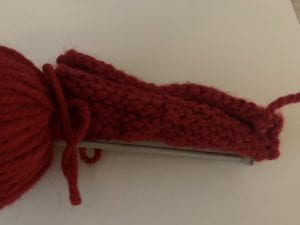One thing that went well during my mentoring sessions these weeks was the pace we went at. I think I learned quite a bit, including different stitches, techniques, information, and I acquired lots of interesting tips from my grandma. However, it was still slow enough to make sure that I knew exactly what I was doing and that I was comfortable with the subjects before moving on.
One challenge that affected our communication was that we weren’t constantly able to be communicating, so if I ran into any problems, it sometimes took a while before we were able to organize a meeting to fix it. As well as that, if I did something wrong but didn’t know it, I wouldn’t know until long after the fact, maybe at the point where it was no longer possible to fix it. For example, when something went wrong with my practice piece, we caught it too late, and I restart the whole square.
The first strategy we could implement in our sessions is to meet at a more regulated and frequent pace, to make it more mentor-like. I could also aim to do my at-home practice closer to when we meet so that any problems or questions I have will be fresh on my mind. The second strategy is to incorporate more time in our sessions simply observing, both me observing her knitting technique and style, and her observing me to see if she has any immediate advice. My last idea is to make sure we communicate more about what I’m doing, what I think, and what problems I may have.
These past weeks I have had a few more meetings with my mentor and we have officially moved out of the planning phase and have started the learning process of the project. In our first meeting, I learned two of the most basic stitches in knitting – a knit stitch, and a purl stitch, which is very similar but is done in an opposite movement. I used part of our meeting and some of my outside time to practice those two stitches. I knitted a small square of about 25×25 stitches. I am now very comfortable with those stitches and can do them at a brisk pace.

My mentor showed me some different patterns I can do with just those two stitches, such as dishcloths, hats, and scarves. She showed me the basics of reading a pattern as well. There are a ton of different abbreviations that are used, and it is very helpful to learn some of those before you try to interpret them. She told me how patterns ask for specific needle width and yarn size, and how they give you a bit of clue of how tight your work should be at the start. It then lists what stitches you do on what row, and how you repeat it (i.e., Row 1: k1, p1). Once I knew that there were a lot of patterns that looked very complicated before, yet no longer seemed too difficult. One thing she told me was that one of the most important things to consider for a beginner in knitting is the tension of your work. It shouldn’t be too tight, or it will be difficult to knit, but it also can’t be too loose. When I was working, we paid extra close attention to the tension.
I have ultimately decided that for my first serious project I’m going to be doing a hat. I’m not sure exactly what style or difficulty I will be doing, but it is a fairly basic item and is one I might consider incorporating into my final project, so it is great to learn. A few ideas I found online:


